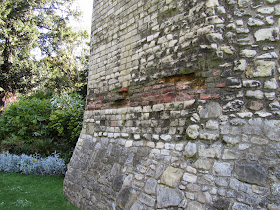Akin to many early English and Continental cities York inherited a very sturdy city wall around its central core. These walls were of vital importance during the restless late Roman and Dark Ages, and continued to be of defensive value well into early modern times.
But when urban life started to get busier in the late 1700s, many cities decided that a course of walls with limited access points was in fact a negative, a drag on modernization and prosperity. So many fine Roman and medieval monuments were smashed down unceremoniously.
In the case of York the walls were of course in disarray. The fortifications of the great Roman fortress had deteriorated dramatically by the time the Vikings showed up. And as to what happened in between, the time of the Anglo-Saxons was almost entirely unknown. Of course medieval building on top of the earlier stuff, then a long gentle decay had caused the walls of York to be a mish-mash of stonework and crumbling ruins.
So it was not surprising that the city fathers applied in 1800 for an Act of Parliament to knock the walls out entirely. What was surprising was the degree of emphatic resistance on the part of far sighted preservationists. Their efforts were not entirely successful, some 300 yards were torn out anyway, but the coherent sense of York as an ancient place is largely intact today, with a fine display of restored walls upon which one can walk and enjoy the city view. Tourism dollars and pounds have certainly far exceeded any short term gain that could have come from wholesale demolition.
Also, a spirit of inquisitiveness was established. People actually thought about what they were seeing in front of them.
By 1839 York was starting to wake up in earnest. That was the year that the railroads came. By some accounts that was also the year that a tunnel was to be dug through the course of the city walls near the old St. Leonard's Hospital. (I have also seen 1842 quoted, and it seems more likely).
The purpose of this tunnel is obscure in the on line sources I have encountered, but my tour guide in York last April gave this version.
At this point in time keeping livestock in the city was common. A farmer had a shed near the earthen berm that was what the city wall had become. He wanted to make a tunnel so that his cows could exit the city to grazing land without having to traipse through the streets. Workmen were employed.
But they came across the foundation of a stone tower. Rather than bash on they stopped, and local antiquarians were called in. The structure was of ambiguous age, but was felt to be from the mysterious interval between Roman and Viking eras. It has been dubbed "The Anglian Tower" for this reason. In fact it sits on Roman foundations and probably was a late Empire structure refurbished by the Angles.
I got a couple of photos of the site, and consider it good fun to try and correlate the images with the history. I can't promise perfect clarity. Neither the morning sunlight nor the Light of History are ideal in this spot.
Brick cow shed on the right. Medievial city wall on the left. The stubby structure in the middle is the Anglian Tower. Recall that in the early 1800s ground level would have hidden the tower entirely.
Close up of the Anglian Tower. The lower levels were excavated in 1970. Many confusing and confounding wall structures of variable dates were exposed. A plaque on the site mentions that one of the excavators, a certain Jeffery Radley, was killed in an accident on the site that summer.
Just to the right of the Tower, set into the brick wall of what looks like the lower level of the "cow shed" we see this:
I am assuming that this was the proposed exit for the bovines. The archway is of indeterminate age and seems to be slopped together from brick and stone. It looks to be about one cow width in size.
As per my earlier mea culpa, details on this site are hard to come by. Some sources indicate the tunnel was a more ambitious venture, not just an impractical way to get to the pasture. Some sources date the excavations on this site to 1969 instead of 1970. And as to the dating and use for the Anglian Tower, well just don't go there. Go Here I guess.
But it is a fine, quiet little spot. Almost nobody goes there. I think most with an interest in the Roman Remains never get past the more famous Multangular Tower which is to be found a short distance away. I think that has been sufficiently written about and photographed so will leave you with only one image and one thought...
Ummmm...the Romans didn't really bury people under their defensive tower, did they? Well of course not. On that topic, lets talk. Next posting.





No comments:
Post a Comment
I'll be putting comments into "moderator" format for a while. Sometimes they get a bit off topic. I'll post almost all of them even the One Weird Trick Spamsters if they amuse me. I also answer my email at dagmarsuarez@gmail.com